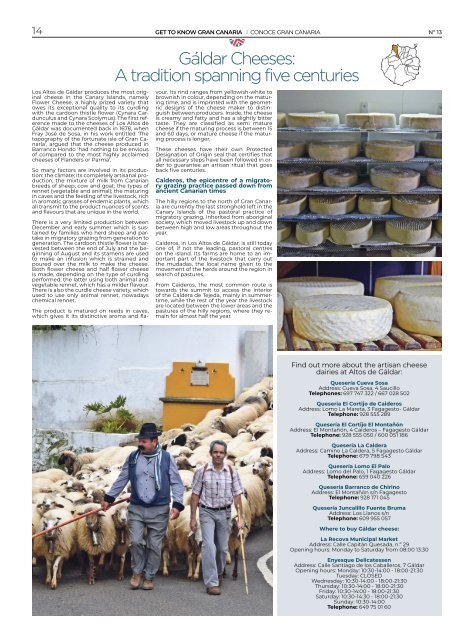No. 13 - Its Gran Canaria Magazine
Rutas, recomendaciones y noticias de Gran Canaria Routes, tips and news about Gran Canaria
Rutas, recomendaciones y noticias de Gran Canaria
Routes, tips and news about Gran Canaria
You also want an ePaper? Increase the reach of your titles
YUMPU automatically turns print PDFs into web optimized ePapers that Google loves.
14<br />
GET TO KNOW GRAN CANARIA I CONOCE GRAN CANARIA Nº <strong>13</strong><br />
Los Altos de Gáldar produces the most original<br />
cheese in the Canary Islands, namely<br />
Flower Cheese, a highly prized variety that<br />
owes its exceptional quality to its curdling<br />
with the cardoon thistle flower (Cynara Cardunculus<br />
and Cynara Scolymus). The first reference<br />
made to the cheeses of Los Altos de<br />
Gáldar was documented back in 1678, when<br />
Fray José de Sosa, in his work entitled 'The<br />
topography of the fortunate isle of <strong>Gran</strong> <strong>Canaria</strong>',<br />
argued that the cheese produced in<br />
Barranco Hondo 'had nothing to be envious<br />
of compared to the most highly acclaimed<br />
cheeses of Flanders or Parma'.<br />
So many factors are involved in its production:<br />
the climate; its completely artisanal production;<br />
the mixture of milk from <strong>Canaria</strong>n<br />
breeds of sheep, cow and goat; the types of<br />
rennet (vegetable and animal); the maturing<br />
in caves and the feeding of the livestock, rich<br />
in aromatic grasses of endemic plants, which<br />
all transmit to the product nuances of scents<br />
and flavours that are unique in the world.<br />
There is a very limited production between<br />
December and early summer which is sustained<br />
by families who herd sheep and partake<br />
in migratory grazing from generation to<br />
generation. The cardoon thistle flower is harvested<br />
between the end of July and the beginning<br />
of August and its stamens are used<br />
to make an infusion which is strained and<br />
poured over the milk to make the cheese.<br />
Both flower cheese and half flower cheese<br />
is made, depending on the type of curdling<br />
performed, the latter using both animal and<br />
vegetable rennet, which has a milder flavour.<br />
There is also the curdle cheese variety, which<br />
used to use only animal rennet, nowadays<br />
chemical rennet.<br />
Gáldar Cheeses:<br />
A tradition spanning five centuries<br />
The product is matured on reeds in caves,<br />
which gives it its distinctive aroma and flavour.<br />
<strong>Its</strong> rind ranges from yellowish-white to<br />
brownish in colour, depending on the maturing<br />
time, and is imprinted with the geometric<br />
designs of the cheese maker to distinguish<br />
between producers. Inside, the cheese<br />
is creamy and fatty and has a slightly bitter<br />
taste. They are classified as semi mature<br />
cheese if the maturing process is between 15<br />
and 60 days, or mature cheese if the maturing<br />
process is longer.<br />
These cheeses have their own Protected<br />
Designation of Origin seal that certifies that<br />
all necessary steps have been followed in order<br />
to guarantee an artisan ritual that goes<br />
back five centuries.<br />
Caideros, the epicentre of a migratory<br />
grazing practice passed down from<br />
ancient <strong>Canaria</strong>n times<br />
The hilly regions to the north of <strong>Gran</strong> <strong>Canaria</strong><br />
are currently the last stronghold left in the<br />
Canary Islands of the pastoral practice of<br />
migratory grazing, inherited from aboriginal<br />
society, which moved livestock up and down<br />
between high and low areas throughout the<br />
year.<br />
Caideros, in Los Altos de Gáldar, is still today<br />
one of, if not the leading, pastoral centres<br />
on the island. <strong>Its</strong> farms are home to an important<br />
part of the livestock that carry out<br />
the mudadas, the local name given to the<br />
movement of the herds around the region in<br />
search of pastures.<br />
From Caideros, the most common route is<br />
towards the summit to access the interior<br />
of the Caldera de Tejeda, mainly in summertime,<br />
while the rest of the year the livestock<br />
are located between the lower areas and the<br />
pastures of the hilly regions, where they remain<br />
for almost half the year.<br />
Find out more about the artisan cheese<br />
dairies at Altos de Gáldar:<br />
Quesería Cueva Sosa<br />
Address: Cueva Sosa, 4 Saucillo<br />
Telephones: 697 747 322 / 667 028 502<br />
Quesería El Cortijo de Caideros<br />
Address: Lomo La Mareta, 3 Fagagesto- Gáldar<br />
Telephone: 928 555 289<br />
Quesería El Cortijo El Montañón<br />
Address: El Montañón, 4 Caideros – Fagagesto Gáldar<br />
Telephone: 928 555 050 / 600 051 186<br />
Quesería La Caldera<br />
Address: Camino La Caldera, 5 Fagagesto Gáldar<br />
Telephone: 679 798 543<br />
Quesería Lomo El Palo<br />
Address: Lomo del Palo, 1 Fagagesto Gáldar<br />
Telephone: 659 040 226<br />
Quesería Barranco de Chirino<br />
Address: El Montañón s/n Fagagesto<br />
Telephone: 928 171 045<br />
Quesería Juncalillo Fuente Bruma<br />
Address: Los Llanos s/n<br />
Telephone: 609 955 057<br />
Where to buy Gáldar cheese:<br />
La Recova Municipal Market<br />
Address: Calle Capitán Quesada, n.º 29<br />
Opening hours: Monday to Saturday from 08:00 <strong>13</strong>:30<br />
Enyesque Delicatessen<br />
Address: Calle Santiago de los Caballeros, 7 Gáldar<br />
Opening hours: Monday: 10:30-14:00 - 18:00-21:30<br />
Tuesday: CLOSED<br />
Wednesday: 10:30-14:00 - 18:00-21:30<br />
Thursday: 10:30-14:00 - 18:00-21:30<br />
Friday: 10:30-14:00 - 18:00-21:30<br />
Saturday: 10:30-14:30 - 18:00-21:30<br />
Sunday: 10:30-14:00<br />
Telephone: 649 75 01 60

















